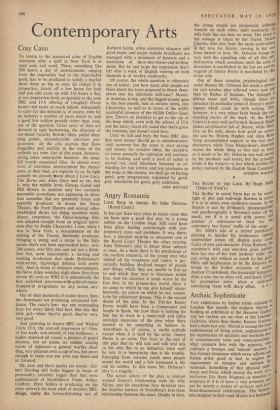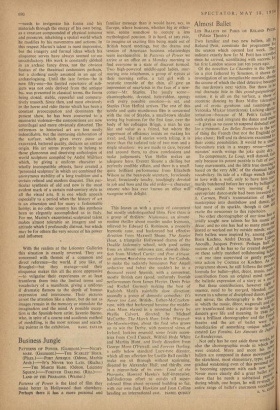Archaic Sophisticate
Two exhibitions by Italian artists coincide London this month; the sculptor Marini holding an exhibition at the Hanover Gall and ten realists are on view at the Leienstc' Galleries, where their leader, Renato Guttusn had a show last year. Marini is among the in°.s sophisticated of living artists, sophisticated it his exploitation of qualities and methods den,1 to contemporary taste and connoisseurshiP• what connects him with the painters, cultivate a brusque and 'natural' manner, that formal eloquence which never allows an) Italian artist, good or bad, to neglect requirement to energise and animate ha'. materials. Something of that physical on" dence and force, which stamps the work a a performer like Anna Magnani, is essential tcd sculpture if it is to have a vital presence.en, not be merely a matter of surfaces and tor: three-dimensional relationships. The hunia.111 istic sculptor in fact—and Marini is a human°
—needs to invigorate his forms and his materials through the energy of his own being, as a creature compounded of physical tensions and pressures, inhabiting a spatial world which he modifies by his movements and actions. In this respect Marini's talent is most impressive, but the imagery and formal ideas which his eloquence serves have always seemed to me unsatisfactory. His work is constantly clothed in an archaic fancy dress, not the obvious fustian of the theatrical costumiers perhaps, but a clothing' easily assumed in an age of archwologising. Until the late forties—he is now fifty-one—his limited repertoire of sub- jects was not only derived from the antique but. was presented in classical terms, the forms being closed, stable, reposeful and compara- tively smooth. Since then, and most obviously in the horse and rider theme which has been a constant preoccupation and dominates the present show, he has been converted to a mannerist violence—the compositions arc now centrifugal and more obviously distorted. The references to historical art are less easily indentifiable, but the increasing elaboration of the surface, which gives every piece an excavated, battered quality, declares an ancient origin. His art seems properly to belong to those glamorous and deceiving anthologies of world sculpture compiled by Andre Malraux which, by giving a uniform character to wholly incompatible /objects, have created a 'perennial sculpture' in which are combined the anonymous stability of a long tradition and a certain refined and modern disquiet. This par- ticular synthesis of old and new is the most evident mark of a certain mid-century style in all the visual arts. It is one which appeals especially to a period when the history of art is an obsession and for many a fashionable hobby; in no other country has this synthesis been so elegantly accomplished as in Italy. For me, Marini's exceptionaL sculptural talent makes almost tolerable an imagery and an attitude which I profoundly distrust, but which may be for others the very source of his power and influence.
With the realists at the Leicester Galleries this situation is exactly reversed. They are concerned with themes of a common and direct reference—the world, if you like, of Brueghel—but they manage—and their eloquence makes this all the more oppressive —to vulgarise their experiences or at least transform them into the limited terms and vocabulary of a manifesto, giving a uniform if dramatic flatness to the depth of human expression and intercourse. Their pictures arrest the attention like a shout, but do not as images remain in the memory or stimulate the imagination and the mind. A possible excep- tion is the Spanish-born artist, Saverio Bueno, who, in spite of a coarse and academic method of Modelling, is the most serious and search-
ing painter in the exhibition. RASH. TAYLOR



































 Previous page
Previous page